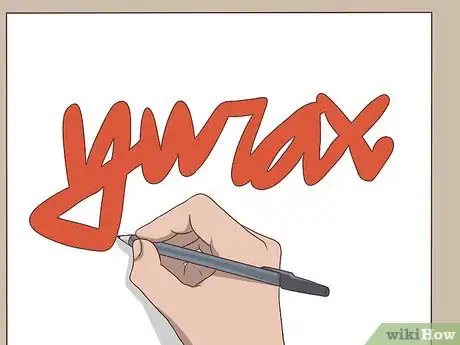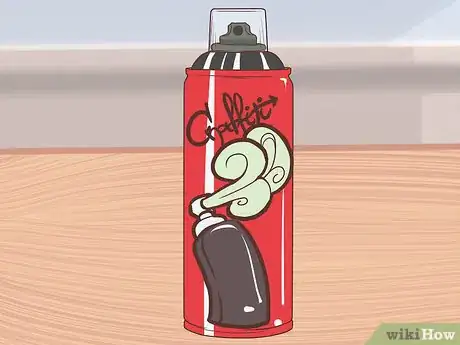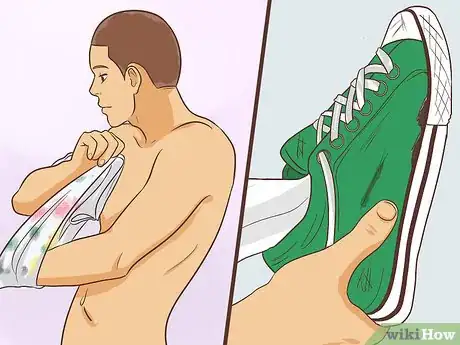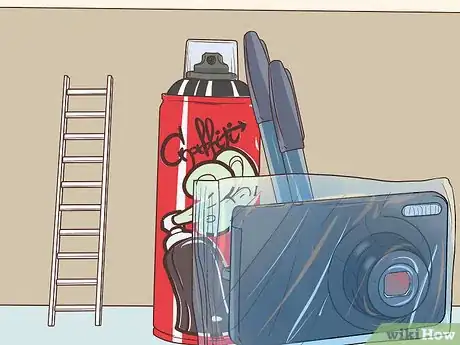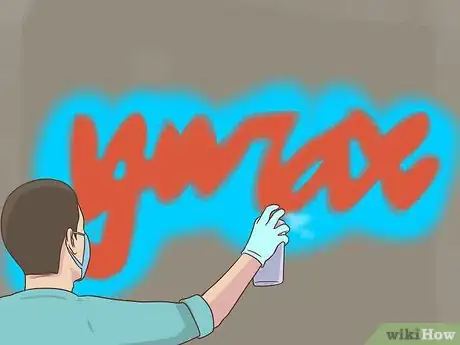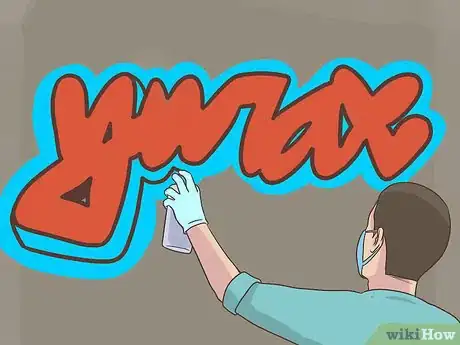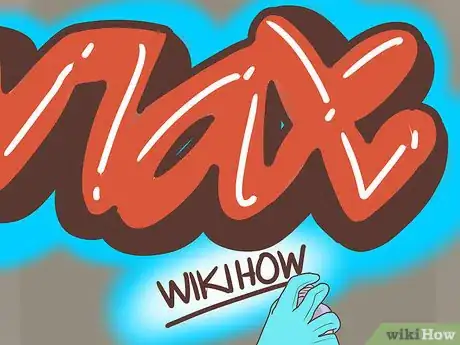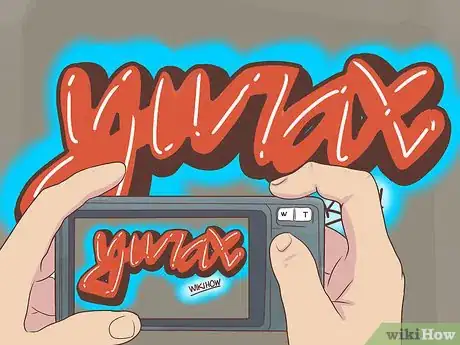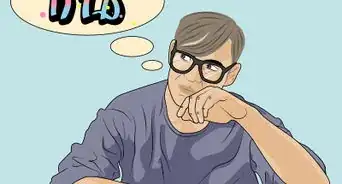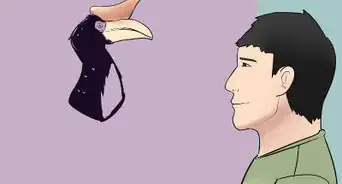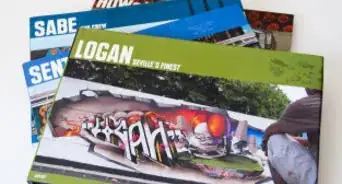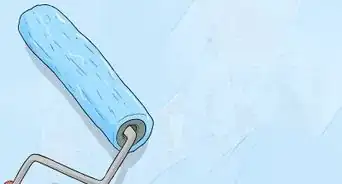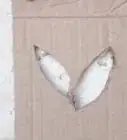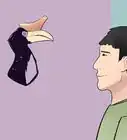X
wikiHow is a “wiki,” similar to Wikipedia, which means that many of our articles are co-written by multiple authors. To create this article, 15 people, some anonymous, worked to edit and improve it over time.
This article has been viewed 34,667 times.
Learn more...
Want to learn how to make graffiti? Even if you understand the techniques of drawing graffiti sketches and writing signatures, you may still be wondering how to get started in making actual graffiti murals. In this article, you will learn how to make excellent graffiti murals.
Steps
Part 1
Part 1 of 3:
Preparing
-
1Find a graffiti signature you can use. Beware that among graffiti artists, "biting", which is having signatures similar to other graffiti artists, is highly frowned upon and can be dangerous. Instead, find or create something unique that is not similar to other graffiti artists' signatures, especially well-known graffiti artists that live in your area.[1]
- Sketch your signature in big letters on an size A4 sheet of paper with a black or blue ballpoint pen.
-
2Buy spray cans from a brand that is designed for graffiti. One of the most reputable brands is Montana. Get both fat and skinny caps to use with your cans as well as thin rubber gloves that fit your hands well. Nitrile gloves like those used in hospitals will work well.
- If you want an even better result, buy normal wall paint from a regular paint store. Use this to paint a layer on the wall with a paint roller before spraying. You will also need a tray for the paint roller. Doing this will help cover up old graffiti on the wall so that it does not show through your "piece" (the name for the composition of letters graffiti artists make). It also will make the background look better and make your "piece" stand out more from the wall. Additionally, other "pieces" that have been made earlier will not distract from your "piece".
Advertisement -
3Wear old or run down clothes and shoes that you do not care if you ruin. There is a significant chance that you will get paint on your clothes and shoes. Wearing a hooded sweater and hat can help you avoid recognition. Bystanders may start taking pictures of you and others present or even filming you from behind while you paint on legal walls without asking; if these images are posted on social media, they can actually lead to legal problems for you later, and no one wants that.
Advertisement
Part 2
Part 2 of 3:
Creating Your "Piece"
-
1Bring your paint, equipment, and a digital camera in a plastic bag and go to a legal wall. Legal walls exist all around the world, and you can often find them by asking employees at the shop where you buy your spray paint or checking online.[2]
-
2Start painting the wall with the wall paint or spray cans and paint roller.[3] If you use an extension shaft for the paint roller, it will make this process much faster and easier. You do not want to wait hours before it dries, so do not use too much paint on the paint roller. Paint a layer large enough to cover the graffiti that is already on the wall completely. Make sure you paint long enough on both sides so that none of the letters become too big and go outside of the field you have painted.
-
3Start spraying with a light color in the way you want the letters to look. This is called "sketching" the letters. If you want to make a cartoon face or portrait somewhere around the "piece", start with that now and follow the same procedure as with the letters. It is important to use a light color because if you want to make adjustments later, a light color can be covered by darker colors. However, the reverse is not necessarily true, so you will see lines from the darker colors come through. You should only make empty letters first without any "fill in" (painting inside the letters). You should also make the shadow or 3D effect on the letters with the same color. Imagine that light is shining on the letters from a certain direction and make the shadow on the opposite side. It is vitally important that you give the shadow the same thickness on all of the letters.
-
4Fill in the letters with the colors you want. Try making patterns and symbols in different colors inside the letters. For the main colors you can use a fat cap, which makes it come a lot of paint from the can, but for the patterns, and especially if you want to make a fading effect, it is better with a skinny cap.[4] This can be anything. It is important that you get finished with the "fill in", before starting with the outline, because you will quickly end up spraying over the outline with the "fill in" colors, because e.g. the wind blows the paint around.
-
5Make the background. Here you also make e.g. patterns and symbols. A smart thing is to choose colors that are colder than the ones you used inside your "piece". Because this will make the background look like it is further away than the letters, which will stick out.
-
6Paint the outline on the letters and shadow (or 3D effect). Use a color that stands out a lot from the colors you have used in the background and inside the letters.[5] Often a dark color is the best, like black, but not always. This is important to make it easy to see the difference between background and "fill in". This is one of the most important steps, because black is hard to cover up, so if you make mistakes when spraying the outline, it will quickly make the "piece" look bad. Take small lines at a time, not whole letters. But from point to point where the letter's shape changes direction. If there are complicated lines, take a "practice swing" to simulate the movement you have to do with the can before starting to spray the line.
-
7Paint the "skyline". This is a line that goes outside the letters and the shadow, that separates the background from the letters. This makes the "piece" much better at once. If you spray over the outline while making the "skyline", just use the color you used for the outline to fix it. But remember to save enough of the outline color until you are finished, to fix the most important things.
-
8Add effects to the "piece" if desired. This is what separates the really great "pieces" from the not so great. Now you can add something called "shining". Which is a line that is white or yellow that you put where the light would shine on the letters. And that is supposed to be on the exact opposite side of the shadow. So where you have shadow, you are not supposed to have "shining" and vice versa. If you make a 3D effect instead, then a "shining" is wrong to make, because if there is no shadow, there is no "shining". It is just like when you draw a person, one place there is shadow and another place there is light.
- You can also make something called an "inline", this is almost the same as an outline, but it is complicated to make and will definitely ruin your "piece" if you do not do it properly. Something the "shining" will also do because these effects are advanced. The "inline" is a line that goes on the inside of your outline in all the letters. This can be very cool, but it is not in all "pieces" this effect is suitable.
Advertisement
Part 3
Part 3 of 3:
Finishing Up and Documenting
-
1Complete any additional (and optional) elements. It is very common to write the year that you made the "piece", and it is also very nice to know when looking in old photo albums. To write the place you made it is also a possibility. Because if you start making a lot of graffiti you are not going to remember when and where you made every "piece". Then you write your signature beside the "piece". The best thing to do is to take a skinny cap and write it on the right side of the "piece" low down under it. Because a huge signature draws a lot of attention, and you do not want the signature to grab the viewer's attention from the big letters.
- After this you can also dedicate your "piece" to someone, and write 4: which means for e.g. "My buddies". You can also write a greeting to someone with Yo. E.g. Yo: Eric and King D. You have to know the people you are greeting; you can not greet to or dedicate your "piece" to, for example, a big graffiti artist you do not know because that is like "saying" that you know him or that he or she said it was okay for you to do it. If you have something smart to say that is short or know a good line from e.g. a rap song you can also write it.
-
2Take several pictures of your "piece" from different angles and lengths with your digital camera. If you can not go a very long distance from the "piece", because some other thing like another wall is blocking you from doing it, the best angle is from the side close up to the "piece". Because then you can get all of it in one picture. The best thing is to use a tripod for your camera, so you get a steady and balanced shot.
- If you do not take a picture at once, remember that at legal walls your "piece" can get painted over at once. Think of the composition when taking the picture, try to get the "piece" as much in the middle of the picture as you can, and make sure that the "piece" is perfectly horizontal in the lense.
Advertisement
Community Q&A
-
QuestionDo I need to wear a mask when painting graffiti?
 Jackpot7777Community AnswerIt's not 100 percent necessary, but strongly advisable in the long run. If you're going to go for it and try to become great, you should definitely get one. If you're painting outside and you do it one time without a mask, you're unlikely to damage your health. If you stand in a room with no ventilation painting for hours, that might cause acute health problems. Common sense gets you far, but generally, yes, it can be hazardous to paint without a mask on.
Jackpot7777Community AnswerIt's not 100 percent necessary, but strongly advisable in the long run. If you're going to go for it and try to become great, you should definitely get one. If you're painting outside and you do it one time without a mask, you're unlikely to damage your health. If you stand in a room with no ventilation painting for hours, that might cause acute health problems. Common sense gets you far, but generally, yes, it can be hazardous to paint without a mask on. -
QuestionHow old do I have to be to get a graffiti permit, and do I have to have one for a legal wall painting?
 Community AnswerYou can contact the city that you wish to graffiti in. They will help you will getting permits as well as with finding a legal wall. The age can vary from city to city but it is likely over 18 in most places.
Community AnswerYou can contact the city that you wish to graffiti in. They will help you will getting permits as well as with finding a legal wall. The age can vary from city to city but it is likely over 18 in most places. -
QuestionHow old do I have to be to do grafitti art?
 Lucy PlowmanCommunity AnswerYou have to be 18 or older to buy the paint, but if you can get someone else to buy it for you, you could start at a younger age.
Lucy PlowmanCommunity AnswerYou have to be 18 or older to buy the paint, but if you can get someone else to buy it for you, you could start at a younger age.
Advertisement
Warnings
- Remember that people will take your statements that you write and the symbols that you use in graffiti as in all art seriously. Graffiti is also an element in hip hop. And a lot of hip hop fans are into a kind of tough culture, so things that are too wimpy can and often will get ridiculed. It's not like you can not paint letters without it having something with graffiti to do, but when making graffiti style "pieces" you are doing an element in hip hop. So something is completely wrong to do, if you understand. Like it is in any other culture. But there are many graffiti artists that make e.g. cartoon characters, so you can make funny stuff. But e.g. racism against blacks is as wrong as it can get.⧼thumbs_response⧽
- Inhaling spray paint is not healthy and can lead to addiction and bad health effects. That is why the best thing to do is to use a gas mask, especially if you are painting inside. But if it is not a proper one you will not be able to breathe sufficiently, so having only a medical face mask or some cheap mask is not good enough. You should get a proper one.⧼thumbs_response⧽
- If you are going to ride in your car with the paint, make sure that you have plastic bags around everything. Especially the bucket of paint. Because if you have to brake hard in traffic, then the paint bucket will fly forward and destroy the interior of your car. Also make sure to take off the caps on the spray cans when taking them from one place to another, so they do not start spraying while you transport them.⧼thumbs_response⧽
- Do not make illegal graffiti around the legal wall where you paint, because it is going to make the authorities shut down the legal wall. I do not encourage people to make illegal graffiti anywhere anyway, and do not condone to it either.⧼thumbs_response⧽
- When you spray where it is windy, or above the height of your face, it is easy to get paint in your eyes, something that can be dangerous. That is why using protective eyewear can be smart. Like sunglasses. But people that hang out on legal walls might start dissing you and laugh at you if you use it.⧼thumbs_response⧽
- What people call the different elements and effects you can use when making graffiti varies, so don't take it for granted that all the expressions here are correct to use where you live.⧼thumbs_response⧽
- Beware that some people hate graffiti and graffiti artists. So telling it to people you do not know is not always smart and can also get you in trouble. All in all making graffiti, even if it is legal can get you in a lot of trouble or cause problems for you. Because they might think you make illegal graffiti and that you are a part of a bad community. So do not tell people, for example, girls you are dating. Because that can lead to them not wanting to have anything more to do with you. Graffiti is a controversial art form and is not even accepted as art by many people.⧼thumbs_response⧽
Advertisement
Things You'll Need
- Spray cans
- Caps for the spray cans
- Rubber gloves
- Paint roller
- Extension shaft for paint roller
- Tray for paint roller
- A bucket of cheap indoor wall paint
- 1 A4 sheet of paper
- 1 black or blue ballpoint pen
- Digital camera
- Mask for the fumes
- Clothes and shoes you do not care if gets ruined
- Small plastic bag for the caps for the spray cans
- A bag or rucksack that you do not care if gets ruined for the cans
- Paper towel or old t-shirts ripped into small pieces
- Plastic bags for the paint equipment and the paint after you have used it
References
- ↑ https://theconversation.com/mcdonalds-accused-of-copying-graffiti-logo-heres-why-we-should-protect-street-artists-original-tags-66855
- ↑ http://legal-walls.net/#lat=47.5378&lng=8.773270000000025&zoom=2
- ↑ https://www.art-is-fun.com/how-to-paint-a-mural
- ↑ https://www.youtube.com/watch?v=nSXuymU16rY
- ↑ https://www.youtube.com/watch?v=sjSqq1SjNtw
About This Article
Advertisement
